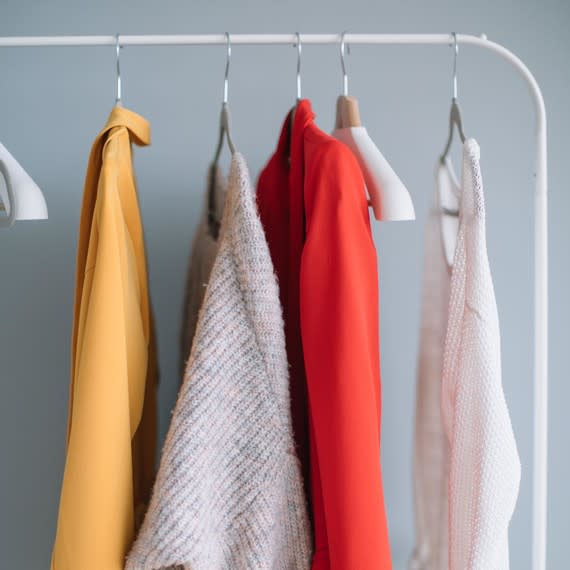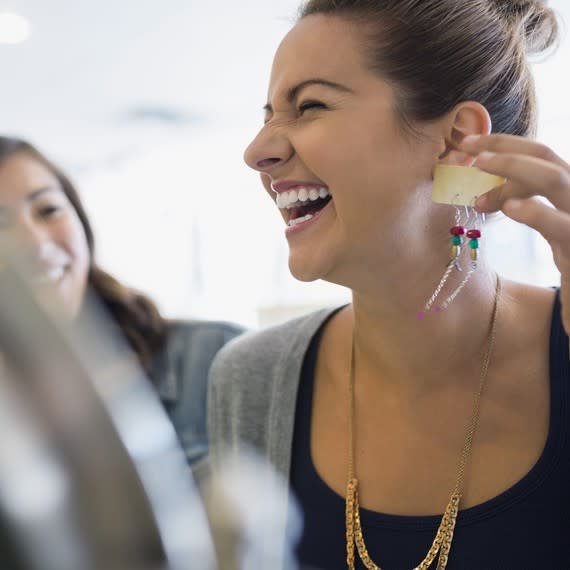How to Host a Clothing Swap

If you’re looking for a fun, free, and eco-friendly way to refresh your wardrobe, consider hosting a clothing swap party. When planned properly, a clothing swap not only invites you and your friends to clean out their closets—haven’t we all been meaning to?—but everyone gets to go home with a fun new fashion haul.
"One of my favorite ways to shop secondhand is hosting a clothing swap," says California-based zero waste blogger, Kathryn Kellogg. "Ring your best pals, ask them to bring over some of the clothes they're thinking about donating. Then, pop some champagne, make a snack platter, and have a blast trying on and swapping the latest trends." By shopping secondhand—even it means trading with your gals—you're also helping to close the fashion waste loop, the second largest source of pollution in the world. "When you buy a new cotton shirt, you're requiring new cotton to be grown, harvested, dyed, sewn, and shipped to the store," Kellogg tells us. Producing a single cotton tee and a pair of jeans can require up to 5,000 gallons of water.
[HERE'S: Why France is Banning Retailers From Tossing Out Clothes]
Convinced to host your own clothing swap soiree? To keep things organized, and make everyone’s shopping experience a smooth one, here are a few pointers to keep in mind, plus pro tips for picking out pre-loved pieces.
Diversify Your Guest List
Once you’ve set a time, date, and location, the most important part of your party planning comes next: building your guest list. You’ll want to do this at least two weeks before the party date so guests have enough time to gather their swap items. And remember, who you invite will determine the items that everyone will be swapping. In other words, include friends (and friends of friends!) of all body shapes and sizes, and personal styles. This will help increase the chances that everyone finds something they like and no one ends up feeling left out.
Determine Donation Guidelines
A good rule of thumb as you gather your swap items: don’t contribute anything you wouldn’t give to a close friend. Sure, clothing swaps are the perfect chance to clear out your closet, but maybe consider contributing last year’s sundress that shrunk a little over your old college sweats. This also means no tattered tees (unless they’re the trendy kind!), missing buttons, broken zippers, or stains. Otherwise, let guests know that all wearable items are up for swapping including apparel, accessories, shoes, bags, and jewelry. Be sure to remind guests to only bring in clean items.
[LEARN: How to Clean and Organize Everything In Your Closet]

Contribute Fairly
To keep the swap as fair as possible, encourage your guests to bring in a minimum and maximum number of items in order to participate, at least five items and no more than 10. This helps ensure that one friend doesn’t bring the bulk of the haul while others only contribute a pair of earrings or a single blouse. Establishing these numbers up front will also make it so there is enough for everyone to go home with something they love.
Stock Up Your Shop
Whether you’re planning on a smaller party size and hosting in a living room, or grew your guest list to fill up a local community center, be sure you have a few basic supplies for the day of the swap. Depending on how many items you’re expecting to collect, you’ll want to have enough tables or clear surfaces for displaying folded sweaters and shirts, clothing racks for hanging up dresses and skirts, hangers, shoe racks, and smaller jewelry stands for displaying necklaces, earrings, and other accessories. Having at least one full sized mirror as well as a smaller one for trying on jewelry will also be essential. Lastly, remind your guests to bring a tote bag for shopping as well as any spares they may have in case someone forgets theirs.
[EXPERT TIPS: Marie Kondo Shows Us How to Keep Our Wardrobes Organized]

Keep Things Organized and Fun
You may be trading pre-loved apparel with your gal pals, but your clothing swap shouldn't feel like you’re just sifting through each other’s bedroom closets. Make the swapping space warm, inviting, and fun. Ask a close friend or two to come a bit early and help you set up items. Decide how you’d like to organize your items (by size, color, or style). Then, create an upbeat playlist to play while guests are shopping, add a bouquet of flowers on the accessories table, and have a few fun appetizers on hand for refueling. Be sure to designate a changing area as well, whether it’s a spare room, guest bathroom, or curtain hung around a corner.
[TRY: 22 Of Our Favorite Last-Minute Appetizers]
Set Up a System
Once your guests have arrived and mingled a bit, they’ll be ready to browse. But in order to ensure two gals don’t end up snagging all the good stuff because they got to “shop” first, figure out a system beforehand. "Do plan, organize, and curate," sustainable fashion influencer and environmental activist, Renee Peters, tells us. "Don’t allow a free-for-all grab-at-once, because nobody wants to walk away feeling like they didn’t have a fair chance to find something they love, while others leave with all the best pieces."
Instead, try dividing your guests into three groups (depending on how many guests you have) and having groups draw numbers for who gets to peruse when. You may also want to set a time for each group to shop and allow each guest to take a maximum number of items. "And finally, don’t throw away unwanted clothes at the end," reminds Peters. "Donate them to a local charity."
Tips for Shopping Secondhand Clothing:
"When it comes to shopping secondhand, there are a few details I look for," Kellogg tells us. First: hold that cute tee up to the light to make sure it's not completely see-through. (Unless you're going for a layering piece.)
Secondhand doesn't have to mean second quality. To ensure you're picking out the best pieces to last a while, Peters says, "Look at the garments’ quality and make sure there aren’t rips or seams coming undone. Even when I buy secondhand, I want to make sure [the clothing] will last me for years."
Be mindful. "I only buy (or in this case, swap) for things that I truly need and love," says Peters. The goal, after all, was to clear our your closet, and the last thing you need in your wardrobe is another impulse item.

